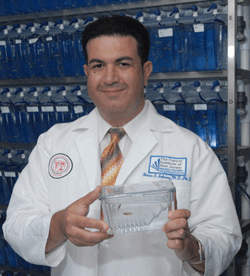Person
Sabaawy, Hatem
|

|
Biography and Research Interest
The research efforts in the Sabaawy laboratory is focused on studying normal and cancer stem cells using human studies, in combination with the zebrafish. These studies aim to dissect stem cell developmental pathways subverted in normal stem cell development, and how cancer stem cells divert from these regulatory pathways. One major pathway for research focus in the lab is to identify targets for modifying self-renewal of normal and cancer stem cells. Using genome-wide modifier screens in conjunction transgenic and xenograft approaches, the laboratory is generating zebrafish models of several different cancers, including the major subtypes of human myeloid and lymphoid leukemias.
One in three children with pre-B acute lymphoblastic leukemia (ALL) carries the t(12;21) translocation marker, making it the most common genetic defect in all childhood cancer, and one that is also found in leukemic blood from adult ALL. The laboratory generated zebrafish with this t(12;21) translocation. These transgenic zebrafish that carry the human fusion develop leukemias similar to human pre-B ALL. Recently, we have also generated zebrafish that have translocations from the endogenous zebrafish sequences. Chemical and genetic modifier screens using tumor-prone zebrafish lines are underway and may ultimately reveal mutant genes or drugs that can suppress or modify disease progression.
A parallel research effort in the Sabaawy laboratory is to study human mesenchymal stroma cell (MSC)-based therapy and transplantation in regenerative medicine. Cell therapy using stem cells for regeneration of a failing organ or injury repair is a promising approach. We are utilizing zebrafish reporter lines with spinal cord injury to study the dynamics of human MSC-mediated repair. These studies support the ongoing collaboration on international trials for utilizing MSCs cell therapy for injury repair.
One in three children with pre-B acute lymphoblastic leukemia (ALL) carries the t(12;21) translocation marker, making it the most common genetic defect in all childhood cancer, and one that is also found in leukemic blood from adult ALL. The laboratory generated zebrafish with this t(12;21) translocation. These transgenic zebrafish that carry the human fusion develop leukemias similar to human pre-B ALL. Recently, we have also generated zebrafish that have translocations from the endogenous zebrafish sequences. Chemical and genetic modifier screens using tumor-prone zebrafish lines are underway and may ultimately reveal mutant genes or drugs that can suppress or modify disease progression.
A parallel research effort in the Sabaawy laboratory is to study human mesenchymal stroma cell (MSC)-based therapy and transplantation in regenerative medicine. Cell therapy using stem cells for regeneration of a failing organ or injury repair is a promising approach. We are utilizing zebrafish reporter lines with spinal cord injury to study the dynamics of human MSC-mediated repair. These studies support the ongoing collaboration on international trials for utilizing MSCs cell therapy for injury repair.
Non-Zebrafish Publications
